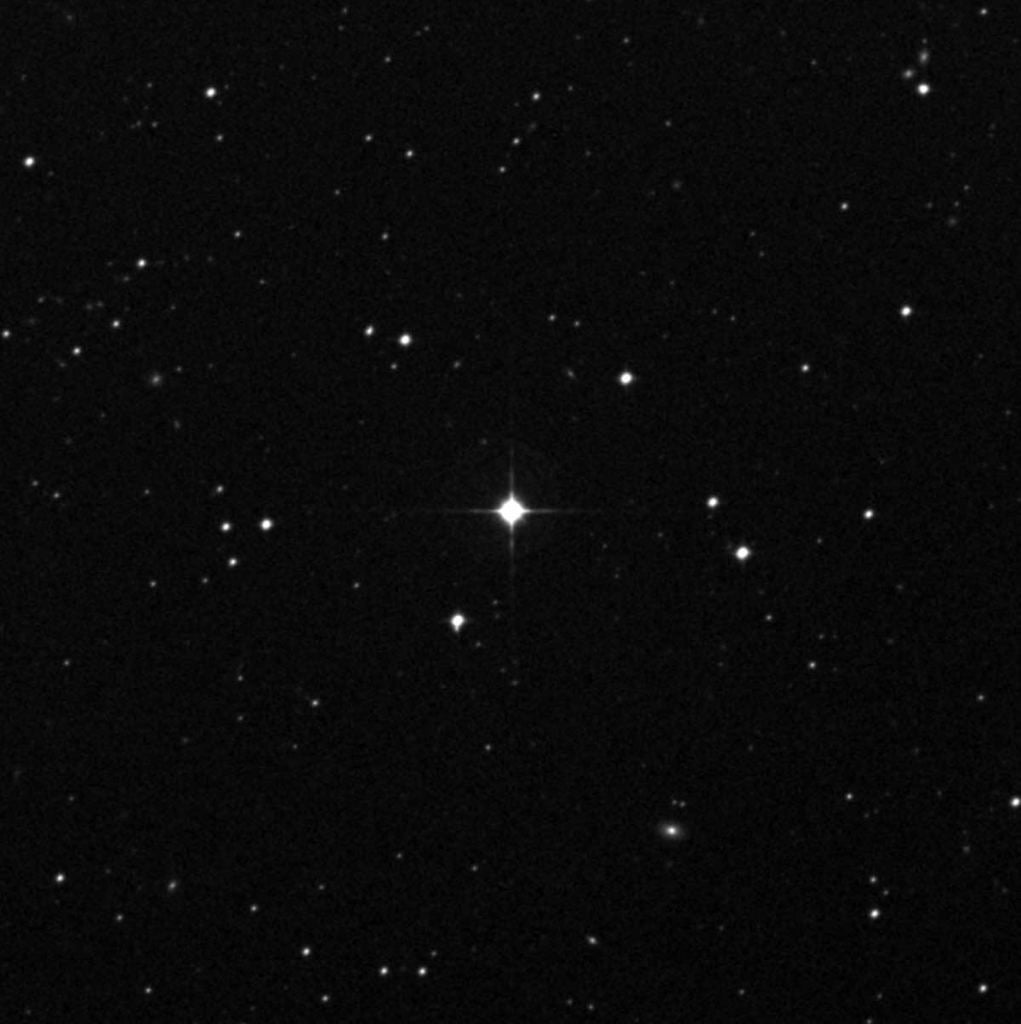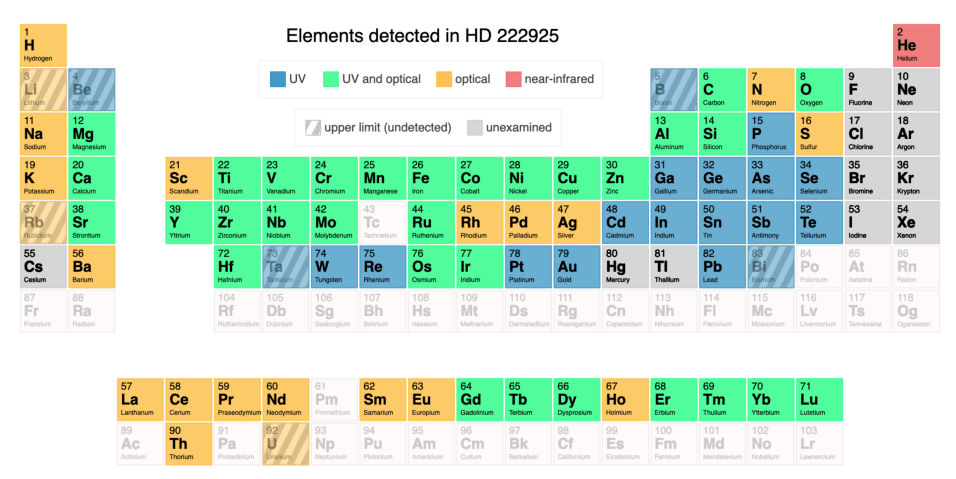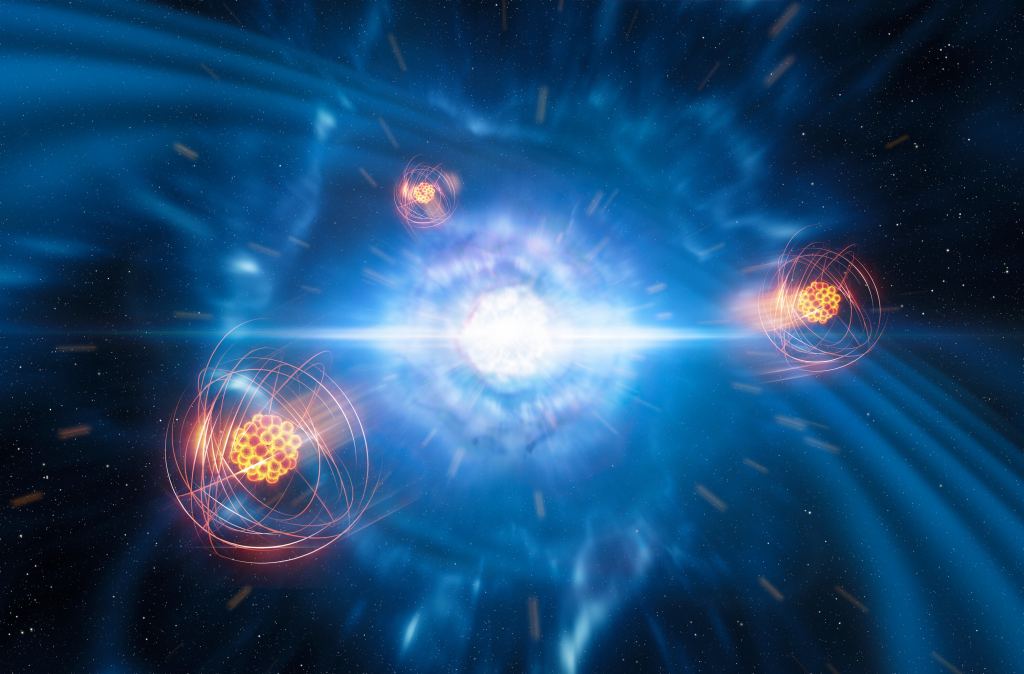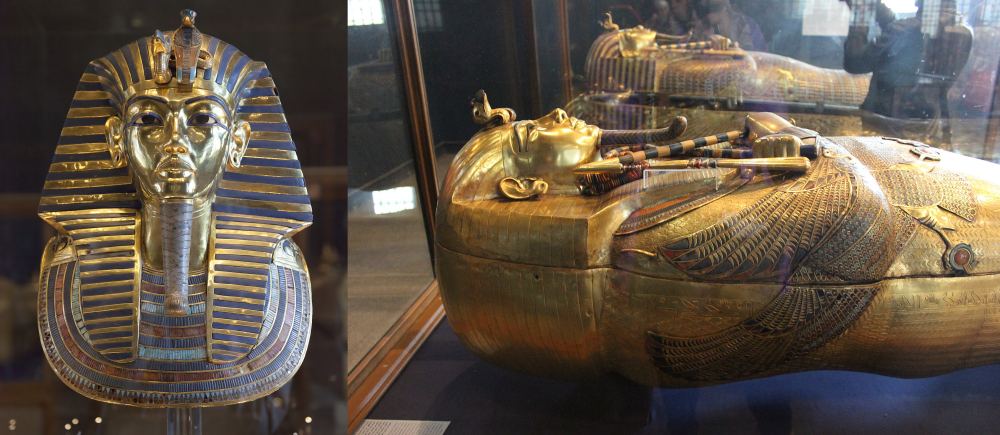Have you ever held a chunk of gold in your hand? Not a little piece of jewelry, but an ounce or more? If you have, you can almost immediately understand what drives humans to want to possess it and know where it comes from.
We know that gold comes from stars. All stars are comprised primarily of hydrogen and helium. But they contain other elements, which astrophysicists refer to as a star's metallicity. Our Sun has a high metallicity and contains 67 different elements, including about 2.5 trillion tons of gold.
Now astronomers have found a distant star that contains 65 elements, the most ever detected in another star. Gold is among them.
There's a fairly bright star in our neighbourhood of the Milky Way named HD 222925. It's close to the southern sky's Tucana (Toucan) constellation. Astronomers are calling it the "gold standard" star because it's their best opportunity to study how stars create some of the heavy elements in the Universe. That process is called the r-process, or rapid neutron capture process.
A new paper presents a chemical inventory for HD 222925 of all the elements produced by the r-process. The paper is " The R-Process Alliance: A Nearly Complete R-Process Abundance Template Derived from Ultraviolet Spectroscopy of the R-Process-Enhanced Metal-Poor Star HD 222925." It's available online at the pre-press site arxiv.org and will be published in the Astrophysical Journal Supplement Series. The lead author is Ian Roederer, an astronomer at the University of Michigan.
HD 222295 is an r-process enhanced but metal-poor star. It has high metallicity, meaning it contains many elements other than hydrogen and helium, but not much of those elements by mass. It's not the first one discovered. That distinction belongs to CS 22892–052, also known as Sneden's star, after the scientist who first identified 53 chemical elements in it. But HD 222295 is much brighter in UV than Sneden's star, making it much easier to observe spectroscopically. That's how the researchers were able to identify 65 different elements.
"To the best of my knowledge, that's a record for any object beyond our Solar System. And what makes this star so unique is that it has a very high relative proportion of the elements listed along the bottom two-thirds of the periodic table. We even detected gold," Roederer said in a press release. "These elements were made by the rapid neutron capture process. That's really the thing we're trying to study: the physics in understanding how, where and when those elements were made."
There are two types of neutron capture: the slow neutron capture process, or s-process, and the r-process. The s-process is reasonably well-understood, but scientists still have significant questions about the r-process. Astrophysicists have a good theoretical understanding of the r-process, but it wasn't observed directly until 2019 when observers saw strontium in the wreckage of a kilonova explosion.
Rapid neutron capture allows an atomic nucleus to capture neutrons quicker than the neutrons can decay, creating heavy elements. The r-process begins with elements lighter than iron. In an environment with lots of neutrons and lots of energy, these lighter elements can capture neutrons since they're neutral and have no charge. When an atom captures a neutron, it emits an electron, converting the neutron into another proton. That raises the atomic number, and the lighter element becomes a heavier element.
These heavier elements—including precious gold—are rarely detected in stars because the astrophysical sites that foster the r-process are rare. "You need lots of neutrons that are free and a very high energy set of conditions to liberate them and add them to the nuclei of atoms," Roederer said. "There aren't very many environments in which that can happen—two, maybe."
This rarity makes the r-process challenging to study, and also what makes the heavier elements, like gold, rare. It's what makes HD 222295 the gold standard.
Neutron star mergers and the resulting kilonova explosions are one of the environments that foster the r-process. Supernovae explosions of massive stars are the other. Nailing down the astrophysical environments that allow the r-process is critical in understanding the r-process. Now astrophysicists want to study the process in more detail.
"That's an important step forward: recognizing where the r-process can occur. But it's a much bigger step to say, 'What did that event actually do? What was produced there?'" Roederer said. "That's where our study comes in."
HD 222295 didn't produce the heavy elements it contains. They were produced earlier in the Universe and then spread into space by either supernovae or kilonovae. Then they were taken up in another generation of star formation, in this case by HD 222295.
"We now know the detailed element-by-element output of some r-process event that happened early in the universe," said study co-author Anna Frebel. Frebel is a physics professor at MIT. "Any model that tries to understand what's going on with the r-process has to be able to reproduce that," she said.
Scientists know that the r-process is one of the main ways stars and their remnants produce heavier elements with atomic numbers greater than 30. Recent observations confirmed that the r-process occurs in neutron star mergers and the resulting kilonova explosions. But there are still some open questions that have persisted for a long time, like which elements it produces and in what abundances?
Those questions led to the creation of the R-Process Alliance, a group of scientists trying to find answers. Some of the authors of this new study are members of the Alliance. This is the second paper published by members of the Alliance that focuses on HD 222295. The researchers think that HD 222295 is one of a group of stars that formed in an environment enriched by the r-process. The star's metallicity is higher than most known stars enriched by the r-process. That suggests that multiple supernovae enriched it. HD 222295 likely didn't form as part of the Milky Way but was captured by our galaxy at some point in the past.
"HD 222925 exhibits no remarkable characteristics in its chemical abundance pattern, other than the overall enhancement of r-process elements," the authors write. "Thus, it may be considered as reflecting the yields of the dominant r-process source(s) in the early universe."
Now that astrophysicists have identified a bright star containing elements from the r-process, it can act as a proxy for what supernovae and kilonovae produce. As researchers create models of the r-process inside these events that creates the heavy elements, those models must have the same signature as HD 222295. Hence, it's the gold standard.
Gold has always held a certain mystique for humanity. It's unique among the elements and made regular appearances in the world's myths. In ancient Greece, the Gods dressed in gold and golden apples conferred mortality on those who ate them if they could get past the dragon that guarded them. In Hindu mythology, gold is the source of power and can transmit divine consciousness. It's also the soul of the world itself.
Those beliefs are wiped away now, lost to time. But the science that replaces them is even more fascinating. The ancients could never have imagined that their myths would be replaced by science and that stars could explode and create gold and other elements. They could never have envisioned gigantic mountain-top telescopes that peer vast distances into space. They could never have imagined that we could cut up a star's light and determine that the star holds gold.
And they could never have guessed that our own Sun contains 2.5 trillion tons of gold.
More:
- Press Release: Astronomers find ‘gold standard’ star in Milky Way
- New Research: The R-Process Alliance: A Nearly Complete R-Process Abundance Template Derived from Ultraviolet Spectroscopy of the R-Process-Enhanced Metal-Poor Star HD 222925
- Universe Today: Astronomers See Strontium in the Kilonova Wreckage, Proof that Neutron Star Collisions Manufacture Heavy Elements in the Universe
 Universe Today
Universe Today




